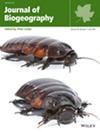Three-Dimensional Morphometrics Reveal Patterns of Unionid Shell Variation Along River Gradients
Abstract
Aim
Understanding the extent of morphological variation across diverse habitats and species can provide valuable insights into how organisms respond to environmental gradients. We quantified intraspecific morphological variation of unionid mussels and assessed how it varied in relation to genetic differentiation and environmental characteristics.
Location
Mobile and Tennessee River Basins, Alabama and Tennessee, U.S.A.
Taxon
Unionid mussels.
Methods
We used innovative three-dimensional (3D) scanning techniques and 3D geometric morphometric analyses, genetic data and environmental variables to quantify morphological variation in seven freshwater mussel species populations and its relationship to genetic differentiation and environmental characteristics.
Results
Our findings indicate that shell morphological variation is correlated with environmental variables in four unionid species, and generally not related to genetic differentiation, improving our understanding of the mechanisms behind morphological variation. Three closely related species were more inflated in larger watersheds, while a more distantly related species, A. plicata, was more compressed in larger watersheds. River bankfull width was a significant factor in all models, highlighting the influence of high flow extremes on shell morphological variation.
Main Conclusions
Our findings suggest that environmental factors, particularly characteristics of river flow regimes, are the primary drivers of intraspecific shell morphological variation in unionid mussels, with genetic differentiation playing a less prominent role. Continuing to explore intraspecific trait variation along river gradients will improve our understanding of the ecological implications of shell morphological variation. Assessing the ability of organisms to morphologically adapt to environmental change can help us understand their resilience.

 求助内容:
求助内容: 应助结果提醒方式:
应助结果提醒方式:


